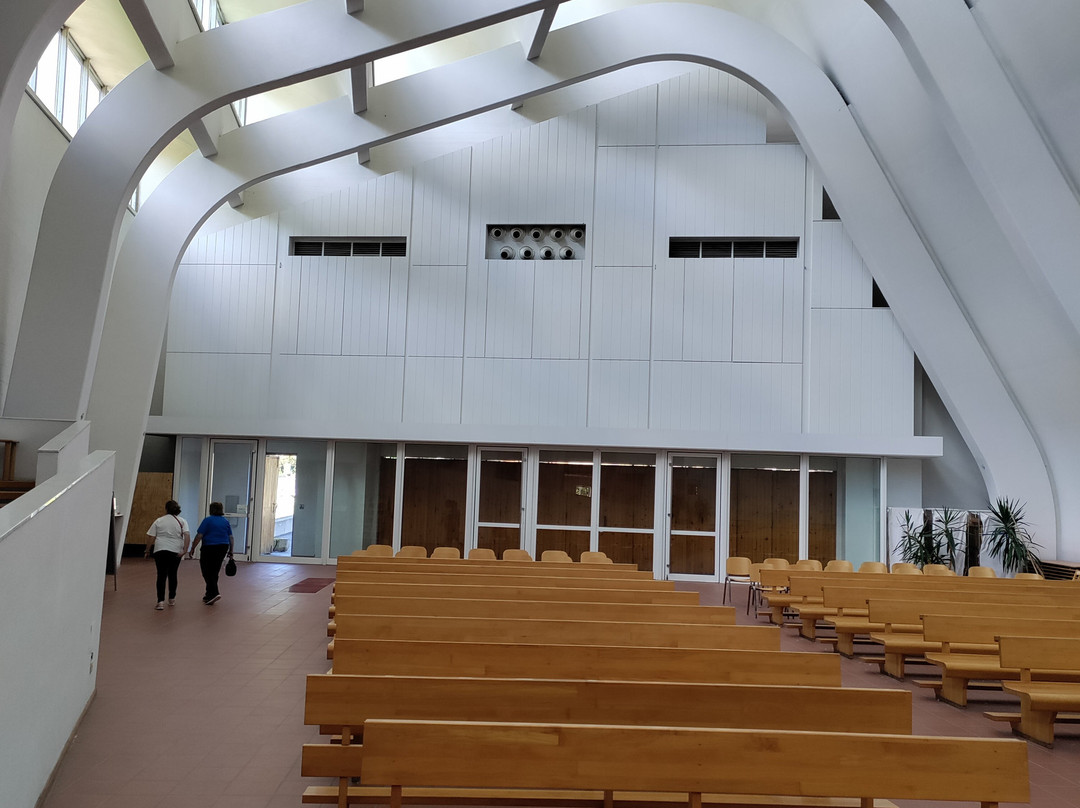的点评
Alvar Aalto's only work in Italy.
Chiesa di Santa Maria Assunta di Riola的点评
点评:In addition to being the only work of the great architect Alvar Aalto in Italy, this church is one of his last works, so much so that he didn't see its completion in 1978.
Knowing his ideas and his architectural practice, the observer will find here the fundamental motifs of Aalto's work. On the one hand, he is considered one of the most representative architects of the so-called "Modern Movement" (or "International Style"), which in the period between the two world wars advocated the need to more closely adapt construction activity to the basic needs of users ("rationality" and "functionality" are fundamental key words). On the other hand, Aalto places a strong emphasis on the relationship between architecture and nature: the architectural work must take into account the surrounding open spaces, and draw inspiration and advantage from them.
These concepts are also visible in the church of Santa Maria Assunta. The single and asymmetrical nave is large and bright, and free of rhetorical/superfluous elements that divert attention: therefore well suited to the well-being and meditation of the faithful. On the other hand, the graceful undulations of the roof ribs recall the elevation of the souls towards the supernatural and at the same time recall the profiles of the mountains surrounding Riola; as the curvilinear profiles of the façade do.
For those who wonder how it's possible that the work of such a renowned architect was built in a tiny village in the Bolognese Apennines, it should be remembered that - as far as I understand - the outcome is due first of all to the firm will of Cardinal Giacomo Lercaro, at the time Archbishop of Bologna, and to the participation of the citizens; they finally managed to overcome skepticism and opposition.
I myself wasn't aware of the existence of this church. But I believe that, if and when a circuit of modern architecture will be organized in a systematic way in Emilia Romagna, this work will have a place of honor.
Knowing his ideas and his architectural practice, the observer will find here the fundamental motifs of Aalto's work. On the one hand, he is considered one of the most representative architects of the so-called "Modern Movement" (or "International Style"), which in the period between the two world wars advocated the need to more closely adapt construction activity to the basic needs of users ("rationality" and "functionality" are fundamental key words). On the other hand, Aalto places a strong emphasis on the relationship between architecture and nature: the architectural work must take into account the surrounding open spaces, and draw inspiration and advantage from them.
These concepts are also visible in the church of Santa Maria Assunta. The single and asymmetrical nave is large and bright, and free of rhetorical/superfluous elements that divert attention: therefore well suited to the well-being and meditation of the faithful. On the other hand, the graceful undulations of the roof ribs recall the elevation of the souls towards the supernatural and at the same time recall the profiles of the mountains surrounding Riola; as the curvilinear profiles of the façade do.
For those who wonder how it's possible that the work of such a renowned architect was built in a tiny village in the Bolognese Apennines, it should be remembered that - as far as I understand - the outcome is due first of all to the firm will of Cardinal Giacomo Lercaro, at the time Archbishop of Bologna, and to the participation of the citizens; they finally managed to overcome skepticism and opposition.
I myself wasn't aware of the existence of this church. But I believe that, if and when a circuit of modern architecture will be organized in a systematic way in Emilia Romagna, this work will have a place of honor.
翻译:这座教堂不仅是伟大建筑师阿尔瓦·阿尔托在意大利的唯一作品,也是他最后的作品之一,以至于他未能亲眼见证其1978年的竣工。
了解他的理念和建筑实践,观者便能在此发现阿尔托作品的基本主题。一方面,他被认为是所谓“现代运动”(或“国际风格”)最具代表性的建筑师之一,该运动在两次世界大战期间倡导建筑活动必须更紧密地适应使用者的基本需求(“理性”和“功能性”是其关键词)。另一方面,阿尔托非常重视建筑与自然的关系:建筑作品必须考虑周围的开放空间,并从中汲取灵感,并从中受益。
这些理念在圣母升天教堂中也得到了体现。单一而不对称的中殿宽敞明亮,没有分散注意力的浮夸元素,因此非常适合信徒的身心健康和冥想。另一方面,屋檐肋条优雅的起伏曲线,令人联想到灵魂升华至超自然,同时也让人联想到里奥拉周围群山的轮廓;正如教堂正面的曲线轮廓一样。
对于那些好奇如此著名建筑师的作品如何可能建在博洛尼亚亚平宁山脉的一个小村庄的人来说,应该记住——据我所知——最终的成果首先归功于时任博洛尼亚大主教贾科莫·莱尔卡罗枢机主教的坚定意志,以及市民的积极参与;他们最终克服了怀疑和反对。
我本人并不知道这座教堂的存在。但我相信,如果在艾米利亚-罗马涅地区系统地组织现代建筑巡回展览,这项工作将占有一席之地。
了解他的理念和建筑实践,观者便能在此发现阿尔托作品的基本主题。一方面,他被认为是所谓“现代运动”(或“国际风格”)最具代表性的建筑师之一,该运动在两次世界大战期间倡导建筑活动必须更紧密地适应使用者的基本需求(“理性”和“功能性”是其关键词)。另一方面,阿尔托非常重视建筑与自然的关系:建筑作品必须考虑周围的开放空间,并从中汲取灵感,并从中受益。
这些理念在圣母升天教堂中也得到了体现。单一而不对称的中殿宽敞明亮,没有分散注意力的浮夸元素,因此非常适合信徒的身心健康和冥想。另一方面,屋檐肋条优雅的起伏曲线,令人联想到灵魂升华至超自然,同时也让人联想到里奥拉周围群山的轮廓;正如教堂正面的曲线轮廓一样。
对于那些好奇如此著名建筑师的作品如何可能建在博洛尼亚亚平宁山脉的一个小村庄的人来说,应该记住——据我所知——最终的成果首先归功于时任博洛尼亚大主教贾科莫·莱尔卡罗枢机主教的坚定意志,以及市民的积极参与;他们最终克服了怀疑和反对。
我本人并不知道这座教堂的存在。但我相信,如果在艾米利亚-罗马涅地区系统地组织现代建筑巡回展览,这项工作将占有一席之地。

此点评仅代表旅行者个人的主观意见,并不代表TripAdvisor以及其合作方的意见。
关于我们
|
新闻动态
|
商务合作
|
会员中心
|
业主中心
|
业主通
|
常见问题
|
意见反馈
|
联系我们
|
营业执照
© 2025 Tripadvisor 版权所有。
使用条款 |隐私政策 |网站工作原理
部分照片由 VFM Leonardo 提供。
* Tripadvisor不是旅行社,也不是旅游预订服务代理商。我们提供免费、客观、公正的旅游资讯服务。 (显示更多)
TripAdvisor LLC 既不是预订代理商,也不是旅游运营商,不会向网站用户收取任何服务费。 按照规定,在 Tripadvisor 发布机票价格、游览和旅行套餐的合作伙伴(航空公司、旅行提供商及预订代理商),其标价须包含所有费用和附加费用。 例如, 机场出入境税费、消费税与其他服务费、手续费、杂费及附加费用。 当您向我们的某个合作伙伴进行预订时,请务必查阅他们的网站以了解当地行政部门要求的所有适用费用的具体情况。 除非另有说明,机票价格通常指的是一个人的价格(以人民币计)。
为方便起见,TripAdvisor LLC 根据从我们的预订合作伙伴获取的空房率计算每个酒店的均价。 对于游览和景点来说,所显示价格通常是每位成人的最低可用价格。 对于列出的任何旅行套餐或优惠,TripAdvisor LLC 无法保证任何特定的费率或价格。 此外,酒店均价每晚会更新,并以您的首选币种表示(使用现行汇率)。 由于这些已换算的价格是预估价格,因此,有关具体金额和币种请与预订网站进行核实。
此外,TripAdvisor LLC 无法保证我们网站上宣传的价格随时有效。 标价可能需要预订一定天数才能生效,或有不可用日期、使用条件或限制。
TripAdvisor公司对外部网站的内容一概不负责。优惠价格中不含税和其他费用。
ICP证:沪B2-20200433
沪ICP备20013175号
 沪公网安备31010502005427号
沪公网安备31010502005427号鹰程信息技术(上海)有限公司
货币/国家及地区
¥CNY
中国

